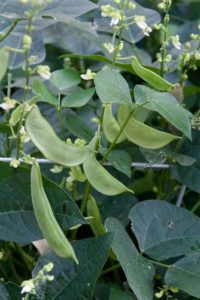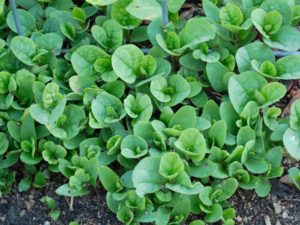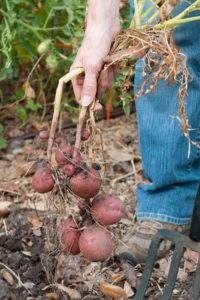
Plant heat-loving butter beans for a delicious summer harvest that will last until frost.
Harvest the June Vegetable Garden Before the Squirrels Wake Up!
June is normally the peak harvest season for many spring-planted vegetables. However, we’ve had such a dry year, that many of you may be experiencing delays or have watched plants wither under the heat. Others have seen early harvests of tomatoes and cucumbers due to warm temperatures. If you haven’t learned it by now, there is no “normal” for Austin vegetable gardeners!
Cracking Tomatoes?
Speaking of tomatoes, the warm days of May have contributed to some vigorous plant growth which may promote cracking of tomatoes. This happens when the fruit enlarges so quickly that it outgrows its skin. Some varieties may be more susceptible to cracking. Hybrids and other varieties like Early Girl, Juliet, Celebrity, Jaune Flamme, and Valley Girl have thicker skin and seem to be more resistant. If you notice cracking, try harvesting fruit at the first blush of pink and let them finish ripening in the house. If you do experience cracked or split tomatoes, they are usually still edible if the cracked or exposed flesh can be cut away.
Prevent Sunburn and Insect Bits While Gardening in the June Vegetable Garden
Take precautions this summer to protect yourself from both mosquitoes and exposure to summer’s intense sun. Wear sunscreen, a hat, long sleeves, pants and sunglasses along with mosquito repellent, such as products with DEET, lemon oil or eucalyptus. Eliminate all sources of standing water – even the ones you don’t think about or see, like shallow plant saucers, gutters, depressions in plastic tarps or folds in lawn bags that might hold even a small amount of water. Cover rainwater containers and/or treat with dunks or granules containing BTI (Bacillus thuringiensis israelensis).
Here is the vegetable gardener’s checklist for June:
FERTILIZE
- Add compost to annuals and vegetables, fertilize only if needed. Scratch the fertilizer into the top layer of soil and water deeply to quickly move the nutrients into solution. Alternatively, use a liquid fertilizer and a siphon mixer to deliver through your irrigation system.
- It’s probably too late to treat for iron chlorosis because our daytime temperatures are in the 80’s. But just in case we get a “cold” spell, provide supplemental iron through foliar applications or drenches, if needed, before daytime temperatures exceed 80°F. Dr. Larry Stein from Texas A&M University recommends EDDHA water soluble chelated iron because it performs the best in alkaline soils.
WATER
- Irrigate deeply and as infrequently as you can to encourage deep roots.
- Keep an eye on container grown vegetable plants. As the temperatures rise and rain diminishes, these plants may require daily watering. Consider using a grow box or other self-watering container to help plants cope with increased water needs.
PLANT
-

Dark green and succulent, Malabar spinach is nutrient rich; chop and sauté with squash, peppers or okra.
Plant okra and sweet potatoes if you haven’t done so already.
- Plant some butter beans such as Jackson Wonder or Henderson
- Plant cream peas or black-eyed peas.
- Sow another crop of corn if you have the room.
- Grow greens that don’t mind the heat of summer such as Malabar spinach, vegetable amaranth or purslane (available online from Johnny’s Seeds or Baker Creek Heirloom Seeds).
- Start tomatoes in pots this month for fall transplanting. Because the fall growing season is shorter, it’s best to stick with early-maturing, determinate varieties. See the full Vegetable Garden Planting Guide (Español, 繁体中文) and Vegetable Varieties for Central Texas.
TRANSPLANT
- It’s time to hold off transplanting new vegetables into the garden. The increased heat makes it hard for plants to draw up enough water while their roots are becoming established.
SOIL
- As you finish up your vegetable harvest, plant a cover crop. I really like buckwheat’ it grows fast, and I can chop and drop it once it starts to bloom. Cover crops are a great way to enrich garden soil for the following season.
- Pull back mulch, apply compost, then replace mulch to retain soil moisture. Pine straw is popular with vegetable growers because it can contribute acidity, it’s loose enough to allow rainwater to soak through but still suppresses weeds. It’s not always available or affordable. You can use unscreened homemade compost in a pinch.
DISEASES/PESTS TO LOOK FOR
- Spider mites tend to show up as the days get hotter and drier. Check for mites by holding a white paper plate underneath a leaf and tap a few times. Dislodged mites will fall onto the plate and look like tiny specks crawling around. Once they are present, the top surface of the leaves will have a pale, stippled appearance. Organic controls for spider mites include horticultural oils, insecticidal soap, sulfur dust or strong blasts of water to the underside of leaves. Once their population explodes, you may see a fine webbing develop under the leaves. At that point it is too late to treat, and the affected plant should be removed from the garden.
- Be on the lookout for aphids. They show up in droves, multiply exponentially and are fairly easy to spot, often on the underside of leaves or along the stems of plants. They can be green, yellow, black or red and are a favorite snack for ladybug and lacewing larvae. Ideally we want to encourage beneficial garden creatures to take care of pests, but if aphids get out of hand their populations can be effectively diminished with targeted sprays of insecticidal soap or by simply washing them off with a strong spray of water. They are a persistent pest and may require repeated spraying to get them under control.
- Squash vine borers are out in full force this month. Check stems daily for eggs and use row cover to keep the moth out. You’ll have to remove the row cover to pollinate the flowers. Pollinate by hand with an artists paint brush or leave the cover off for an hour in the afternoon when the moth is least active.
- Harvest ripe vegetables before spraying plants with any pesticide, whether organic or synthetic. Always read the label for instructions on mixing, dilution, how often to spray, or if there is a waiting period after spraying. If infestations are heavy, remove the plants and replace with something else.
MAINTENANCE
- Stake peppers and eggplant to provide support as they go into production.
- Keep up with weeding to prevent them from setting seeds. They will put on a growth spurt in June to try to complete their reproductive cycle.
HARVEST

Harvest potatoes when the tops turn yellow and begin to die down.
- Harvest vegetables frequently to ensure peak quality and encourage continual production. Morning is usually best – especially if you want to beat the squirrels.
- Dig potatoes when the tops turn yellow and start to die back; handle carefully to avoid bruising. Cure in a warm, humid spot for 1-2 weeks then store in a single layer in a cool, dark location. Washing may encourage disease so wash just before eating.
- If cracking is a problem with tomatoes, harvest at first blush and let them ripen off the vine.
- Harvest sweet potato leaves. They are delicious fresh or cooked. Harvesting leaves will reduce your potato yield but they are so good it’s totally worth it.
- Green beans generally produce a concentrated set of pods over a 2-4 week period before petering out. Cut and remove the plants at soil level when they’ve finished and replace with heat-tolerant southern beans.
- Harvest onions and garlic when tops fall over. Cure in a warm, dry location for a few days before storing.
Additional Resources
Watch the Vegetable Gardening in Central Texas Webinar
Vegetable Planting Calendar (English) (Español) (繁体中文)
Recommended Vegetable Varieties for Travis County
Plant Rotations, Successions and Intercropping
Monthly Gardening Calendar for Austin and Central Texas
About Sheryl Williams
 Sheryl Williams has been a Travis County Master Gardener since 2010 and currently works as the Horticulture Program Assistant at Texas A&M AgriLife Extension – Travis County. She was introduced to gardening by her mom and grandma and has been an avid vegetable gardener most of her life. Sheryl believes that there is nothing more satisfying than growing and preparing your own food. She likes gardening in Austin year round and concedes that means pulling weeds every day. She practices organic gardening principles and enjoys the challenge of outsmarting garden pests. Occasionally she loses these battles, but doesn’t mind sharing a good meal.
Sheryl Williams has been a Travis County Master Gardener since 2010 and currently works as the Horticulture Program Assistant at Texas A&M AgriLife Extension – Travis County. She was introduced to gardening by her mom and grandma and has been an avid vegetable gardener most of her life. Sheryl believes that there is nothing more satisfying than growing and preparing your own food. She likes gardening in Austin year round and concedes that means pulling weeds every day. She practices organic gardening principles and enjoys the challenge of outsmarting garden pests. Occasionally she loses these battles, but doesn’t mind sharing a good meal.

